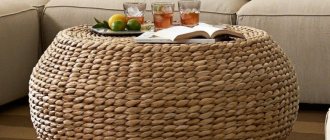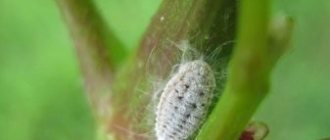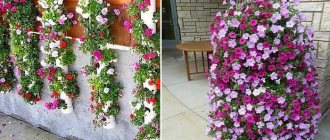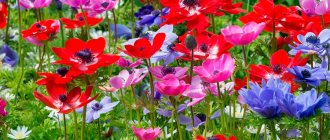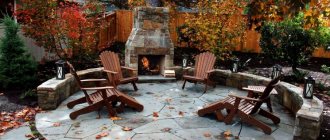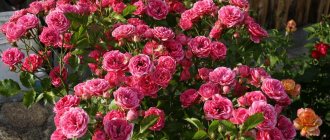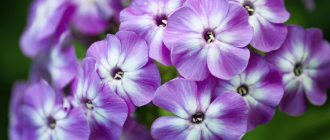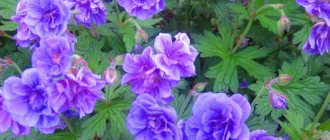The fashion for monochrome flower beds has reached our latitudes. Among all the options for a garden designed in one color, a monochrome garden in red is the most difficult to implement and the most expressive. The fiery energy of flowers and plants in red decoration gives rise to an uncontrollable desire for action and lifts your spirits. But there are certain difficulties in using red in garden compositions. It is necessary to very carefully select shades and halftones in order to avoid excessive variegation and emphasize the advantages of plants.
What problems does a monochrome garden in red solve?
Using the winning red color in a monochrome garden allows you to place the necessary accents and highlight certain areas of the garden.
You will find even more monochrome gardens in our articles “Creating a White Garden” and “Creating a Blue Garden”.
Place red flower beds near active recreation areas
Compositions designed in red tones and garden “scarlet” rooms are best located where you usually gather with friends - next to the patio or barbecue area. Scarlet and burgundy flowers will create a festive mood and promote relaxed communication in a large friendly company. This color stimulates activity and releases energy. It would be appropriate next to a play area for children or a sports ground.
Plant red flowers in front gardens
The color red and its shades attract attention and help create a bright accent on the place that you would like to highlight. It is indispensable in the front entrance area, in the flower beds under the window, which the eye often catches.
Shrubs with red foliage reduce depth
But not only flowers are red, but also trees and shrubs. Their foliage often has a muted, dark burgundy hue. If you plant such a plant in the background of a garden composition, you can visually reduce the depth of the area. Red color brings objects visually closer. Use this feature if you need to adjust the shape of your property or highlight some part of the garden.
On the contrary, if you want to add depth to the composition and elongate the perspective, add plants with blue and light blue flowers. Sprinkles of blue well dilute the monotony of the red garden.
Monochrome garden color
Most often, with such landscaping, white, blue or blue, red or orange, pink or purple, yellow are used as the dominant color.
White. Shades of white can be warm and cold, and it is not advisable to mix them. This must be taken into account when selecting plants based on the tone of the inflorescences. For flower beds in a white garden, you can use lilies, white tulips, chrysanthemums, peonies, violets, hyacinths, and asters. Primroses, Iberis, snapdragons, aquilegias and bluebells can be white. Flowering shrubs include hydrangea, clematis, spirea, bird cherry, magnolia, and roses. You can complement the white garden with decorative foliage species (cineraria, woodworm, wormwood with silvery foliage). Ornamental grasses (feather grass, barley) and trees with white trunks (poplar, birch) look good in such a garden. White gardens are often called lunar gardens: they remain beautiful and bright even at night. In addition, it is the white flowers that often have the strongest scent.
Blue or blue. He may appear cold and rather reserved. Blue and blue tones differ in saturation and depth, they can be combined with each other, further complicating the palette. Forget-me-nots, lobelias, speedwells, sage, and delphiniums bloom in blue. Among shrubs, such flowering can occur in hydrangea and clematis. Buddleias, wisterias, New Mexican Robinia, and phacelias can complement this palette. More saturated, deep blue colors are found in periwinkle, bluebells, scilla, muscari, and cornflowers. They can be supplemented with blue varieties of clematis, aquilegia, and delphiniums. In the blue garden you can also plant crocuses, irises, eryngium, and bruners. Pansies and forget-me-nots, morning glories, ageratums, and lobelias can also be used for flower beds.
Yellow. One of the most striking landscaping options - the garden will look sunny even in cloudy weather. For flower beds, you can use decorative sunflowers, marigolds, yellow dahlias, rudbeckia, eschscholzia, tulips, hazel grouse, and swimsuits. Many medicinal plants bloom yellow, including calendula, yarrow, and goldenrod. You can complement flower beds or flower beds with decorative foliage species. Euonymus, forsythia, privet with light foliage, barberry Aurea, spirea, elderberry Aurea will support the yellow range. In the yellow garden you can also plant broom, mahonia, daylily, rudbeckia, and snapdragon. You can also use trees with yellow inflorescences: buddleia, bobwhite, caranga.
Red and orange. Often, with monochrome landscaping, these colors are combined to create a common palette. Orange looks brighter than red, but in general both tones are very active and saturated. When decorating a monochrome garden in red or orange colors, moderation is especially important: there should not be too many flowering plants or they should not be too bright. Calendulas, daylilies, coreopsis, cosmos, and crocosmia bloom in orange. Poppies, scarlet flax, zinnias, adonis, dahlias, cannas, roses, chrysanthemums, heucheras and many other species and varieties can be red. You can maintain the scarlet color scheme by planting shrubs and trees with decorative red bark: white, blood-red or scion dogwood, bird cherry, strawberry (prefers a warm climate, requires shelter for the winter). Many conifers have a reddish tint to their bark, including cypresses, some pines, and sequoias. Such a garden can be supplemented with decorative foliage species. Hedges or borders can be formed from barberry with red foliage. Japanese or red maples will look beautiful - the shade of their foliage is so bright that in the sun the trees seem to be blazing. Blood-red heuchera and celosia can be planted as part of flower beds. Coleus can complement flower beds or form borders. Their foliage can be red, green, or with a combined variegated color, which allows you to form unusual contrasting plantings from coleus, arranging them in rows or tiers. Amaranths, bergenias, morning glory, and hibiscus have red foliage. Red juveniles look unusual - they can be used in flower beds and as part of rocky gardens.
Purple and pink. These are cold, slightly muted shades, from which it is convenient to form the overall range. Many plants bloom purple: clematis, hyacinths, primroses, violas, irises, lilacs. Flower beds can be supplemented with plantings of purple hazel, some forms of maple (Royal Red, palmifolia), and purple mackerel. To prevent the purple garden from being too dark or faded, it can be “diluted” with pink flowers: asters, phlox, begonia, hydrangea. In flower beds you can plant bush or climbing roses, delphiniums, petunias, phlox and many other species. “Cold” and light pink and purple shades go well with silver or gray foliage, so flower beds can be supplemented with wormwood, decorative foliage chickweed, and cineraria.
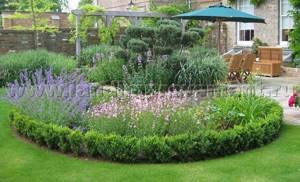
Difficulties in creating a red garden
Recognized masters of landscape design advise avoiding voluminous flower arrangements in red tones. The fact is that large arrays of bright red flowers can tire you and cause feelings of anxiety and aggression. It is necessary to dilute the leading color with another, for example, green. This is what happens most often, because foliage also participates in creating the ensemble.
You should also avoid using different shades of the same color in flower beds. This brings disharmony and disorder. Attention wanders. It is better if you take plants of the same variety and create a bright spot of color. It is also possible to use flowers of different shades of red, but with the same shape of inflorescences - for example, roses, zinnias.
You can enhance the dramatic effect by adding silver and purple tones to your flower bed. The red will appear crimson, gain depth and additional volume.
If you include shrubs and trees in your mixborder, remember that many of them turn various shades of red, orange and burgundy in the fall. Consider seasonal changes when composing compositions.
Arrange a flower garden without flowers
In classic multi-colored gardens, greenery serves, by and large, as just a background for more colorful elements of the composition. Typically, green serves as a contrast that is designed to make flowers stand out. At the same time, green flower beds often become the only way out of a situation when there is a need to arrange a flower garden in the shade. The fact is that beautifully flowering plants absolutely need sunlight. Without it, flowering will be sparse and faded, if at all. Therefore, if you are faced with the task of arranging an area that is located in deep shade, this means that creating a flowerbed without flowers is exactly what you need.
In addition to the decorative leafy crops already mentioned above, various types of grasses, ground covers and conifers can be used in green monoflowers.
- A flower garden without flowers - an oxymoron or a spectacular solution for your garden?
A flower garden without flowers - an oxymoron or a spectacular solution for your garden?
Monoflowers are a timeless classic of landscape design. Would you like to arrange at least one such flower bed on your site?
Red borders and flower beds
Spectacular borders of red flowers along the path in the front area are a garden classic. Strict flower beds with scarlet petunias and salvias planted on them look great in the front garden in front of the house. They attract attention and create a solemn, festive look. Try to use one type of plant and not get carried away with shades of red. The composition must have a finished appearance and a clear structure. Otherwise, you will not be able to create the desired impression.
What is monozone?
The prefix “mono” clearly indicates that we are talking about a corner of the garden consisting of plants of the same species. These can be shrubs, decorative deciduous and flowering perennials, annual flowers.
Mono-planting as a decorative element is most often used to create accent spots. And this is not surprising, since its main task is to emphasize the beauty of the chosen plant and draw attention to it.
Such compositions may consist of:
- from one type and one variety of flowers - in this case monochromatic compositions are obtained;
- from different varieties of one type of plant - multi-colored flower beds;
- from collection plants of one species.
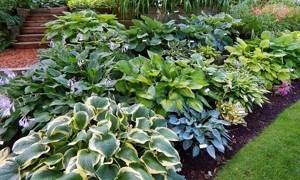
Agree, if hostas were scattered throughout the garden, they wouldn’t look so impressive
A mono-composition can consist 100% of one type of plant or have small inclusions of other garden crops, the main task of which is to create an advantageous backdrop for the “protagonist” of the flowerbed.
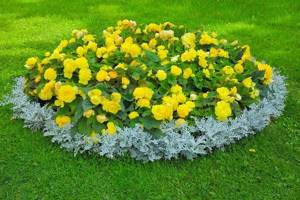
A border made of decorative wormwood emphasizes the delicate beauty of begonias and prevents the flower bed from blending into the lawn
Red roses are the queens of the garden
If you are planning to create a monochrome garden in red tones, you cannot do without roses. Fiery, scarlet, beautiful, like love itself, they are simply created for the romantic corners of the red garden. The enchanting aroma of these magnificent plants enhances the impression of the holiday and helps you feel the joy of life.
Use roses of different shades of red to decorate pergolas and gazebos, and cover garden arches with climbing roses. Choose varieties with long flowering - then you can admire the floral splendor throughout the summer.
Build tiers
If you are a beginner and have not yet mastered all the intricacies of landscape science very well, try to give preference to simple solutions. It’s better to choose the right combination of simple colors than to stupidly place overseas wonders around the flowerbed.
So, the first thing to consider when creating a monochrome flower garden is its tiering. To prevent a monochromatic flower bed from looking boring, alternate plants with round and large leaves and narrow and small leaves. In this case, it is customary to place wider leaves in the background, while smaller ones should be brought to the foreground. The same can be said for flowers. It is these principles that are played out in the illustration example with hydrangea, cornflower and daisies.
Many crops have varieties with white flowers, for example, mock orange, tree hydrangea, daffodils, tulips, dicentra, saxifrage, bells, irises, aquilegia, roses, peonies, etc.
Red color in a Japanese garden
The symbol of power and greatness is the shining red color. In former times in Japan, only the emperor had the right to wear a kimono of this color. Red color is an integral part of the garden composition, designed in the style of the East. Interestingly, in China and Japan it symbolizes power, prosperity, and brings wealth and prosperity to the family. Don't miss the opportunity to add red accents to your oriental garden. Perhaps this will bring you success.
Learn more about Japanese and Chinese philosophy in creating gardens in the articles “DIY Feng Shui Garden” and “Philosophy of the Japanese Garden.”
Single-color flower bed and mono-flower bed: what's the difference?
The foreign prefix “mono” indicates that only one variety of plants will sit in the flowerbed. Those. you create a kind of continuous carpet of tulips, hyacinths, salvia, etc. The flowers do not have to all be the same color, but the appearance, height and bloom time should match.
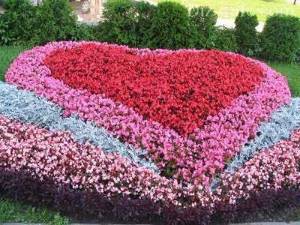
The three types of petunias used in the flowerbed are broken up only by a silver stripe of cineraria, which serves as a transition from dark pink to light plant varieties
A one-color flowerbed is a different design option. In this case, different plants are planted, but only those that match the color of the leaves and buds are selected.
Bright flashes under the window
If you do not like monotony and are not afraid of experiments, use annuals. With their help, you can create a mobile garden composition in red tones in the blink of an eye. Plant bright scarlet geraniums, multi-colored petunias, painted in all colors and shades of red, and begonias in pots and flowerpots. They will bloom continuously all summer, shining with bright lights. One has only to look at them and the mood immediately lifts.
Place pots with flowering annuals on the steps of the stairs, decorate the balcony railings with them, and place them on the window sills. A boost of energy in the morning and excellent well-being are guaranteed for the whole summer!
Fans of the red garden - who are they?
Red color is energy itself. He is adored by active, cheerful people with the makings of a leader. It suits their fiery nature. Often famous people, celebrities, choose a garden project in red colors. They are also accustomed to attracting attention, arousing curiosity and delighting the public with their presence.
So, you have seen how many possibilities the creation of a “red” garden opens up. You will not only correct the shape of the area and concentrate the attention of guests on focal points, but also attract good luck. This is what Eastern wisdom says. And you are guaranteed a great mood and a sea of positive emotions.
Invite the holidays into your monochrome garden. Don't be afraid of interested glances!
Principles of combining plants in single-color flower beds
Assortment of flowers by color
When a one-color flower bed is assembled, it is quite difficult to get into one tone. Usually a monochrome palette is selected. For example, if a pink base tone is chosen, then the flowers can be light pink, dark pink, blurry red, etc. From a distance, such a flower bed will play with tints of tones, and this looks beautiful.
Depending on the location and size of the flower bed, it is made the same in height or multi-tiered. Small flower beds look better with low-growing flowers, large ones with multi-stage compositions.

To divide plants into tiers, transitional links such as cereals or tall grasses are used, which add greenery to the pattern and slightly break up the monotony of the flowerbed.
Be sure to take into account the flowering period of all plantings so that the flower bed blooms all season, maintaining the given color.
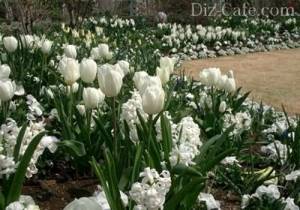
If a wedding is planned in the house in the summer, then white flower beds will become an excellent natural decoration for such a celebration, giving a ceremonial mood to the entire area
Option #1 – blue-blue flowerbed
For a blue flower bed you can collect the following types of plants:
- early flowering: certain varieties of anemones, hyacinths, scylla;
- May flowering: muscari, viper onion, iris, flax;
- June: phlox, Austrian speedwell, Damascus nigella;
- July-August: gladioli, meadow geranium;
- blooming all summer: lobelia erinus, felicia amelloides (in other words, blue daisy);
- autumn: asters.
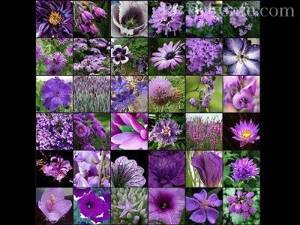
From such a purple variety of plants, you can choose those that take root better in your climate and are inexpensive
Option #2 – yellow flowerbed
For a flower bed in yellow shades, the following are best suited:
- early flowering: primroses, forsythia (ornamental shrub), daffodils, crocuses;
- May flowering: tulips, irises, aquilegia;
- June: doronicum, climbing roses;
- July-August: heliopsis, decorative sunflower, rudbeckia;
- blooming all summer and autumn: helenium, marigolds, meadowsweet yarrow, cannas.
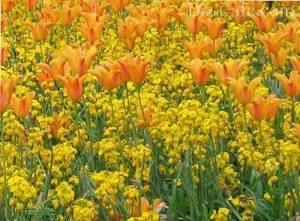
A flowerbed in monochrome yellow-orange tones was created from only two types of plants mixed together. Moreover, the lower tier serves as a background for tall tulips
